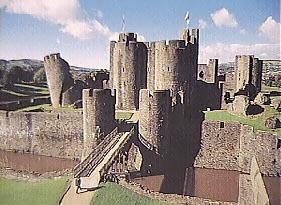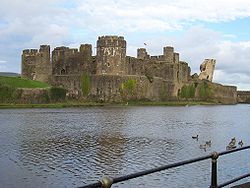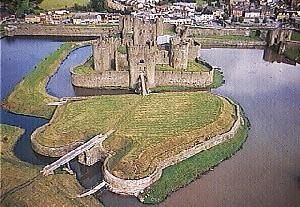Caerphilly Castle

he interest and extraordinary impact of Caerphilly derive from its enormous size, together with the complexity of its land and water defences. In all, it covers some 30 acres, and represents the might of medieval military architecture on a majestic scale. Seen mirrored in the still waters of its great lake, or rising mysteriously through a morning mist, the castle presents a prospect rarely surpassed in these islands.
Not surprisingly, the strategic qualities of the site were first recognized by the Romans. During their military conquest of south-east Wales, a fort for about 500 auxiliary soldiers was established at Caerphilly around AD 75. Abandoned some 50 years later, the location was not reoccupied during the early Norman Invasion of Glamorgan in the late 11th century. At this time, the new conquerors were content to concentrate on the fertile coastal plains, and the mountainous uplands were left largely to the Welsh. Thus, Caerphilly Mountain effectively formed a geographical barrier between Welsh and Anglo-Norman for almost 200 years. Then, in the 1260s, the minor native lords of upland Glamorgan found themselves caught up in the embroilments of national politics. To the north, the ambitious last Welsh prince of Wales, Llywelyn ap Gruffudd, was in effective control of Breconshire and was poised to move further south. But the powerful Marcher lord, Gilbert de Clare was determined to avoid such catastrophe, and in 1267 he responded by moving rapidly north. He captured the native ruler, Gruffudd ap Rhys, and in the following year took the opportunity to begin the construction of Caerphilly itself.

Although de Clare must have planned a mighty new fortress, it is doubtful that he had any conception of how large and elaborate the finished work would be. Nor was his conflict with Llywelyn over yet. Construction of the formidable defences had scarcely begun before the castle was attacked and burnt by the prince's forces in 1270. Only through skillful negotiation, and the intervention of King Henry III, was full-scale war avoided. On the withdrawal of Llywelyn, de Clare regained Caerphilly and continued building in 1271. It is unlikely that the work was finished at his death in 1295, and operations must have gone on under his son, another Gilbert, who died at the Battle of Bannockburn in 1314.
Caerphilly was built to a concentric design with successive lines of defence set one inside the other, so that when the attacker stormed he would find himself face to face with a second. This system of defence saw its fullest development in Edward I's great castles in north Wales. Although the moat is obviously wide and wet enough, and the walls intimidating enough, the defensive principles at the site can only be understood, in their totality, from the air. A seemingly impregnable series of concentric stone and water radiates, in a succession of larger and larger circles, from the central inner ward.

The first line of defence against any attack was the outer moat, spanned by two drawbridges, and backed by a huge curtain wall and gatehouse. The lakes made it almost impossible to use many of the normal methods of siege warfare. Stone-firing catapults could not be brought within range; siege ladders were virtually useless, and it was totally impracticable to tunnel under the waters to undermine the walls.
The inner moat and the gatehouses of the outer ward were the second line of defence. Finally, there stands at the very heart of the castle, the inner ward. This is a very large quadrangle enclosed by four curtain walls, with massive round towers at each corner and yet more gatehouses on the east and west sides. These huge gatehouses protect the points of entry and could be shut off and held separately should the rest of the castle fall. That on the east is by far the more impressive, and contained the constable's hall and other accommodation. In design, it set a pattern later adopted by Edward I at Harlech and Beaumaris./
From the de Clares, Caerphilly passed to the Despensers, and in 1316 it was attacked during the revolt of Llywelyn Bren. Hugh le Despenser the younger earned the hatred of the Welsh by putting Llywelyn to death in 1318. Caerphilly probably saw some further action during the Civil War, but the details are not clear. The effects of gunpowder are perhaps evident in the famous "leaning tower" of the inner ward, though this could be due to ground subsidence.